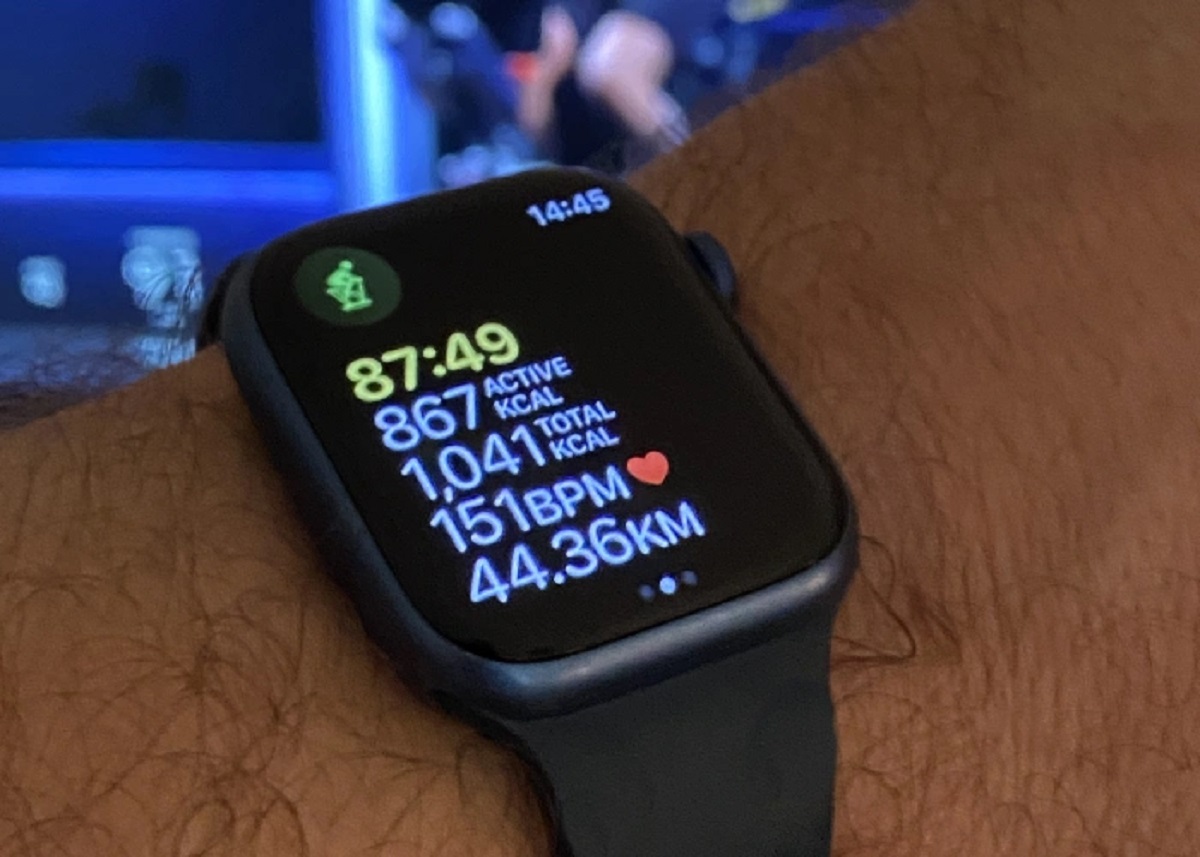Introduction
Welcome to the world of traditional strength training on the Apple Watch! In this modern age of digital fitness, the Apple Watch has emerged as a versatile companion for tracking various types of workouts. While it is widely known for its efficiency in monitoring cardio exercises like running and cycling, many people are unaware that the Apple Watch can also be a powerful tool for tracking traditional strength training workouts.
Traditional strength training, often referred to as resistance training, is a form of exercise that focuses on building muscle strength and endurance through the use of weights or resistance. This type of training is commonly performed in gyms and fitness centers using equipment such as dumbbells, barbells, and weight machines.
Now, you might be wondering why traditional strength training is important, considering the popularity of other forms of exercise. Well, the benefits of strength training go far beyond just building muscle mass. It helps improve bone density, enhances joint stability, increases metabolism, and promotes overall physical well-being. Incorporating strength training into your fitness routine can bring about tremendous improvements in strength, endurance, and body composition.
So how does the Apple Watch come into play when it comes to tracking your traditional strength training sessions? The Apple Watch is equipped with powerful sensors and algorithms that allow it to accurately monitor your movements, heart rate, and calories burned during workouts. Additionally, it offers a variety of useful features and tools to help you optimize your strength training sessions and keep track of your progress.
In this article, we will explore how to set up traditional strength training on your Apple Watch, how to use it to track your workouts, and how to analyze and review your progress. We will also share some valuable tips and tricks to make the most out of your traditional strength training sessions using the Apple Watch. So without further ado, let’s dive into the world of traditional strength training on the Apple Watch!
What Is Traditional Strength Training?
Traditional strength training, also known as resistance training, is a type of exercise that aims to improve muscle strength, endurance, and overall physical performance. Unlike cardiovascular exercises that focus on enhancing cardiovascular fitness, traditional strength training primarily targets the musculoskeletal system.
This form of training involves using external resistance, such as weights, resistance bands, or machines, to work against the muscles. By applying resistance, the muscles are forced to exert more effort, leading to muscle fiber tears, which then regenerate and become stronger, denser, and more resilient over time.
Traditional strength training offers a wide range of benefits. First and foremost, it helps to increase muscle strength and size. By challenging your muscles with progressively heavier loads, strength training stimulates the growth of muscle fibers, resulting in greater strength and power.
Besides improving strength, traditional strength training also enhances endurance. As the muscles become more conditioned, they are able to sustain effort for extended periods, making everyday activities easier and reducing the risk of fatigue-related injuries.
In addition to building strength and endurance, traditional strength training can have a positive impact on body composition. It helps to increase lean muscle mass, which in turn can boost metabolism and aid in weight management. As muscle tissue is more metabolically active than fat, individuals who engage in regular strength training often experience improved metabolic rates.
Furthermore, traditional strength training plays a crucial role in promoting bone health and preventing bone loss. The resistance placed on the bones during strength training exercises stimulates the production of new bone tissue, increasing bone density and reducing the risk of osteoporosis or fractures.
Overall, traditional strength training is a versatile and effective form of exercise with numerous benefits for physical health and performance. It is not limited to bodybuilders or athletes; anyone can participate and reap the benefits, regardless of gender, age, or fitness level. Incorporating traditional strength training into your fitness routine can improve your strength, endurance, body composition, and overall well-being.
Why Is Traditional Strength Training Important?
Traditional strength training is a vital component of a well-rounded fitness regimen. While many people associate strength training with bodybuilders or professional athletes, it is equally valuable for individuals of all ages and fitness levels. Here are some compelling reasons why traditional strength training should not be overlooked:
1. Increased muscle strength and power: One of the primary benefits of traditional strength training is its ability to enhance muscle strength and power. Regularly challenging your muscles with resistance exercises results in improved muscle fiber recruitment and greater overall strength. This increased strength translates into improved performance in daily activities and reduced risk of injury.
2. Enhanced metabolism and weight management: Strength training has been shown to increase resting metabolic rate (RMR). As you gain lean muscle mass through strength training, your body burns more calories at rest to maintain that muscle tissue. This increase in RMR can support weight management efforts and make it easier to maintain a healthy body composition.
3. Improved bone density and reduced risk of osteoporosis: Strength training places stress on your bones, stimulating the body to increase the production of new bone tissue. This can help increase bone density and reduce the risk of osteoporosis, a condition characterized by weak and fragile bones. Building and maintaining strong bones is especially important as we age.
4. Better joint health and injury prevention: Strength training exercises not only strengthen the muscles but also improve joint stability and flexibility. By developing a strong musculoskeletal system, you can better support your joints, reducing the risk of common injuries and conditions such as strains, sprains, and joint degeneration.
5. Functional fitness and improved quality of life: Strength training focuses on movements that mimic daily activities, such as lifting, carrying, and pushing. By improving strength and function in these movements, you enhance your overall fitness and ability to perform daily tasks with ease. This can have a significant impact on your quality of life, especially as you age.
6. Better body composition and aesthetic appeal: Strength training helps shape and tone your muscles, leading to a more defined and aesthetically appealing physique. It can help reduce body fat, increase muscle tone, and improve overall body composition. However, it’s important to remember that strength training is not solely about appearance but also about improving overall health and well-being.
7. Mental health benefits: Engaging in regular strength training has been linked to improved mental health and well-being. The physical exertion involved in strength training triggers the release of endorphins, which are mood-enhancing hormones. Additionally, strength training can boost self-confidence, reduce anxiety and depression, and improve overall cognitive function.
From increased muscle strength and power to improved bone density, traditional strength training offers a multitude of benefits for your physical and mental well-being. Incorporating strength training exercises into your fitness routine can help you achieve a balanced and healthy lifestyle while enhancing your overall quality of life.
How Does the Apple Watch Track Traditional Strength Training?
The Apple Watch is equipped with advanced sensors and sophisticated algorithms that enable it to accurately track traditional strength training workouts. While it may not have built-in weightlifting-specific features like exercise detection for every strength training movement, it relies on a combination of motion tracking, heart rate monitoring, and user input to provide a comprehensive overview of your workout session.
The Apple Watch utilizes the built-in accelerometer and gyroscope to detect your movement and analyze your exercise patterns. When you engage in traditional strength training exercises, such as squats, bench presses, or bicep curls, the Apple Watch can detect the specific movements associated with these exercises and estimate the number of repetitions performed.
In addition to motion tracking, the Apple Watch uses its optical heart rate sensor to monitor your heart rate during your strength training session. By measuring your heart rate, the Apple Watch can provide insights into the intensity of your workout and calculate the number of calories burned. This information can be valuable for tracking your progress and optimizing your training intensity.
While the Apple Watch does its best to automatically track your traditional strength training exercises, it also provides the ability for manual input. You can use the Workout app on the Apple Watch to select the “Strength Training” activity and input the type of exercise, sets, reps, and weights used. This manual input ensures that you have more accurate and detailed tracking of your workouts.
Furthermore, the Apple Watch offers different workout metrics display options, such as elapsed time, heart rate, calories burned, and more. You can customize your metrics display to suit your preferences and monitor your workout statistics in real-time.
It’s worth noting that while the Apple Watch can track traditional strength training exercises and provide valuable data, it may not be as accurate as specialized fitness trackers or manual tracking methods. Factors such as the type of exercise, form, and range of motion can affect the accuracy of the tracking.
However, by combining a mix of motion tracking, heart rate monitoring, and user input, the Apple Watch offers a convenient and insightful way to track your traditional strength training workouts. It allows you to monitor your progress, adjust your training intensity, and stay motivated on your fitness journey.
Setting Up Traditional Strength Training on Your Apple Watch
Before you can start tracking your traditional strength training workouts on your Apple Watch, you need to set up the appropriate settings and preferences. Here’s how you can get started:
1. Update your Apple Watch Software: Make sure that your Apple Watch has the latest software updates installed. This ensures that you have access to the most up-to-date features and enhancements specifically related to fitness tracking.
2. Customizing your Workout App: Open the Apple Watch app on your iPhone and navigate to the “My Watch” tab. Scroll down and tap on the “Workout” option. Here, you can customize the settings for your Workout app, such as enabling the “Detect Gym Equipment” feature. This feature allows your Apple Watch to automatically recognize common strength training exercises.
3. Adjusting Wrist Detection: To ensure accurate heart rate monitoring during your workouts, ensure that “Wrist Detection” is enabled on your Apple Watch. This setting can be accessed by going to the “Settings” app on your Apple Watch, tapping on “Passcode,” and then toggling “Wrist Detection” on.
4. Choosing the Right Workout Type: When you initiate a workout session on your Apple Watch, select the “Strength Training” activity from the available options. This tells your Apple Watch to optimize its tracking and metrics for traditional strength training exercises.
5. Manual Input: While the Apple Watch does its best to automatically track your strength training exercises, it is always beneficial to provide manual input for a more accurate record of your workout. Use the “Add Set” option during your workout to manually input the exercise, sets, reps, and weights used. This ensures that you have precise tracking of your lifts and can review your progress more effectively.
6. Adjusting Workout Metrics Display: Customize the metrics displayed during your workout by using the “Multiple Metric” or “Single Metric” options on your Apple Watch. This allows you to choose the workout statistics that are most relevant and valuable to you during your strength training session.
7. Syncing with Fitness Apps: If you use third-party fitness apps to track your strength training, ensure that they are compatible with the Apple Health app. By syncing your fitness apps with Apple Health, you can seamlessly transfer your workout data between devices and have a centralized record of your fitness activities.
By following these steps and personalizing the settings of your Apple Watch, you can optimize the tracking and monitoring of your traditional strength training workouts. Remember, the Apple Watch is a powerful tool, but it’s always a good idea to double-check and manually input your workout details for more precise tracking and analysis.
Using the Apple Watch to Track Your Traditional Strength Training Workouts
Once you have set up your Apple Watch for traditional strength training, you can begin using it to track your workouts. Here’s how you can make the most out of this feature:
1. Initiate a Workout: Open the Workout app on your Apple Watch and select the “Strength Training” activity. This sets the stage for your traditional strength training session.
2. Warm-up and Calibration: Before diving into your main workout, it is essential to perform a warm-up. The Apple Watch will automatically detect this warm-up phase and calibrate its tracking accordingly.
3. Perform Your Strength Training Exercises: As you move through your strength training routine, the Apple Watch will attempt to automatically track your exercises based on motion detection. However, be prepared to provide manual input for exercises that may not be recognized accurately.
4. Input Reps, Sets, and Weights: For each set of an exercise, you have the option to manually input the number of repetitions, sets, and weights used. This ensures more accurate tracking and allows you to review your progress more effectively.
5. Monitor Your Heart Rate: The Apple Watch continuously monitors your heart rate during your strength training session. Keep an eye on your heart rate to gauge the intensity of your workout and ensure you are within your desired target zone.
6. Utilize the Rest Timer: The Apple Watch also offers a useful rest timer feature. After completing a set, activate the rest timer to ensure you’re taking appropriate rest periods between sets. This can help optimize your training and prevent overexertion.
7. Analyze Metrics During and After Workout: While you’re in the midst of your strength training workout, you can swipe right on the Apple Watch screen to view various workout metrics. Customize the displayed metrics to focus on the data that matters most to you, such as heart rate, calories burned, or elapsed time.
8. Review Workout Summary: After completing your strength training session, the Apple Watch provides a comprehensive summary of your workout, including total duration, average heart rate, calories burned, and more. Take a moment to review this information to track your progress and set goals for future workouts.
9. Sync with Fitness Apps: If you use fitness apps that complement your strength training routine, ensure they are connected to the Apple Health app. This allows for seamless syncing of workout data, giving you a holistic view of your fitness journey.
By utilizing the tracking capabilities of the Apple Watch, monitoring your heart rate, and taking advantage of manual input and customization features, you can effectively track and analyze your traditional strength training workouts. This information can help you gauge your progress, make adjustments to your training, and stay motivated on your path to achieving your fitness goals.
Analyzing and Reviewing Your Traditional Strength Training Workouts on the Apple Watch
One of the advantages of using the Apple Watch for traditional strength training is the ability to analyze and review your workouts. Here’s how you can make the most out of this feature:
1. Workout App Summary: After each strength training session, the Apple Watch provides a summary of your workout. This includes total duration, average heart rate, calories burned, and other essential metrics. Take a moment to review this summary to get an overview of your performance.
2. Exercise Metrics: In addition to the overall workout summary, you can view exercise-specific metrics for each exercise you performed during the session. This includes details such as sets, reps, and weights used. Use this information to track your progress over time and identify areas for improvement.
3. Progress and Trends: The Apple Watch also allows you to track your progress and view trends over time. You can check how your strength and endurance have improved, observe fluctuations in heart rate, and see changes in calories burned. These trends provide valuable insights into the effectiveness of your training and help you set realistic goals.
4. Achievements and Awards: As you continue to engage in strength training workouts, the Apple Watch recognizes your efforts and rewards you with achievements and awards. These milestones can serve as motivation and encourage you to keep pushing yourself.
5. Third-Party Apps: The Apple Watch is compatible with numerous third-party fitness apps that specialize in strength training tracking and analysis. You can sync these apps with your Apple Watch and gain access to additional features, such as advanced workout analytics, personalized recommendations, and detailed progress reports.
6. Share Your Results: The Apple Watch allows you to share your workout results and achievements with friends, family, or on social media. Sharing your accomplishments can help you stay accountable, inspire others, and foster a sense of community around your fitness journey.
7. Review Your Technique: In addition to tracking workout metrics, the Apple Watch offers a unique feature called the “Review” option. This allows you to replay your strength training exercise movement on the screen, offering an opportunity to evaluate your technique, form, and range of motion. This visual feedback can help you refine your technique and optimize the effectiveness of your exercises.
By analyzing and reviewing your traditional strength training workouts on the Apple Watch, you can gain valuable insights into your performance, progress, and areas for improvement. Use this information to refine your training plan, set achievable goals, and stay motivated on your journey to becoming stronger and fitter.
Tips and Tricks for Optimizing Traditional Strength Training on the Apple Watch
When it comes to optimizing your traditional strength training workouts on the Apple Watch, there are several tips and tricks you can employ to enhance your experience. Here are some valuable suggestions:
1. Calibrate Your Movements: To ensure accurate motion tracking, calibrate your movements by performing exercises with proper form. Proper form ensures that the Apple Watch can detect and recognize your movements accurately.
2. Use Manual Input: While the Apple Watch does its best to automatically track your strength training exercises, it’s always a good idea to provide manual input for exercises that may not be accurately detected. Take advantage of the “Add Set” option to enter the exercise, sets, reps, and weights used.
3. Track Rest Periods: Set the rest timer feature on your Apple Watch to time your rest intervals between sets. Proper rest periods help optimize your training and prevent overexertion.
4. Customize Metrics Display: Customize the metrics displayed during your workout to focus on the information that matters most to you. Whether it’s heart rate, calories burned, or elapsed time, choose the metrics that align with your goals and preferences.
5. Utilize Third-Party Apps: Explore third-party fitness apps that are compatible with the Apple Watch and offer specialized features for strength training. These apps often provide additional workout analytics, personalized recommendations, and insights to further optimize your training sessions.
6. Seek Professional Guidance: If you’re new to strength training or want to take your workouts to the next level, consider consulting a professional fitness trainer or strength coach. They can provide guidance on proper technique, exercise selection, and training programs that align with your goals.
7. Set Realistic Goals: Use the data and insights provided by the Apple Watch to set realistic goals for your strength training. Whether it’s increasing your maximum weight lifted, improving your repetition count, or decreasing rest periods, setting specific and attainable goals can help drive your progress.
8. Consistency is Key: The Apple Watch is a powerful tool, but it’s important to remember that progress takes time and consistency. Aim for consistency in your strength training workouts, ensuring regularity to see sustainable improvements in strength, endurance, and overall fitness.
9. Listen to Your Body: Pay attention to your body’s signals and adjust your training accordingly. If you experience pain or discomfort during an exercise, it’s important to modify or stop the movement to prevent injury. The Apple Watch provides valuable feedback, but always prioritize your safety and well-being.
By incorporating these tips and tricks into your traditional strength training routine on the Apple Watch, you can optimize your workouts, track your progress accurately, and work towards achieving your fitness goals effectively.
Final Thoughts
Traditional strength training combined with the power and tracking capabilities of the Apple Watch can revolutionize the way you approach your fitness journey. From tracking your workouts to analyzing your progress, the Apple Watch provides a wealth of features to optimize your strength training experience.
Remember, traditional strength training is not just for bodybuilders or elite athletes. It is a beneficial form of exercise for individuals of all ages and fitness levels. By incorporating strength training into your routine, you can improve muscle strength, enhance metabolism, promote bone health, and enjoy a wide range of physical and mental health benefits.
While the Apple Watch may not have specialized features for every strength training movement, it can effectively track and monitor your workouts using motion detection, heart rate monitoring, and manual input. By properly setting up your Apple Watch and utilizing its features, you can accurately record your exercises, sets, reps, weights used, and other metrics.
Analyzing the data from your traditional strength training workouts on the Apple Watch allows you to track your progress, identify areas for improvement, and stay motivated on your fitness journey. Take advantage of the ability to review exercise metrics, monitor trends, and share your achievements to stay accountable and motivated.
Optimizing your traditional strength training sessions on the Apple Watch also involves implementing various tips and tricks. Calibrating your movements, utilizing manual input, customizing metrics display, and exploring third-party apps are some strategies that can enhance your training experience.
Ultimately, consistency, listening to your body, and setting realistic goals are key to achieving long-term success with traditional strength training. The Apple Watch can be a valuable companion on this journey, providing valuable insights and support along the way.
So, embrace the power of the Apple Watch and traditional strength training. Combine technology and exercise to unleash your full potential and transform your fitness routine. Get ready to lift, track, analyze, and conquer your fitness goals with the Apple Watch by your side!

























